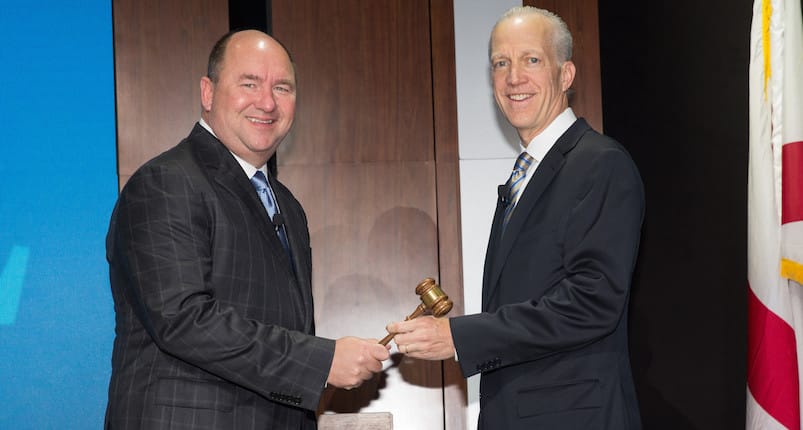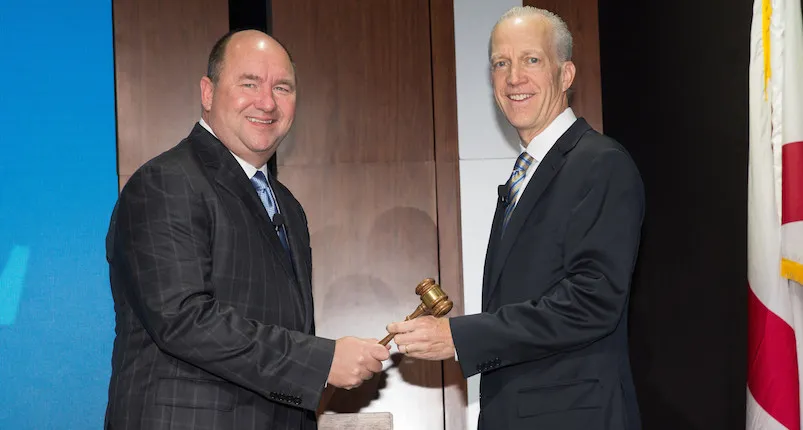
At the Annual Meeting, outgoing NACDS chairman Randy Edeker of Hy-Vee hands the gavel to successor Martin Otto of H-E-B.
PALM BEACH, Fla. — The U.S. health care system is not functioning in a sustainable way, new National Association of Chain Drug Stores chairman Martin Otto said at the organization’s Annual Meeting here last month. Costs are too high and are rising fast, while outcomes are disappointing.
“There are a number of structural issues in health care that we’ve got to address as a nation,” Otto said. “My hope is, through NACDS, we can be a part of the solution.”
Otto, who is the chief merchant and chief financial officer at H-E-B, characterized the U.S. health care industry’s situation as akin to standing on a burning platform, or being a passenger on the Titanic.
“Health care spending in the United States in 2013 was 18% of GDP, now it’s 20%,” Otto said. “In other developed nations, it’s 10% to 12%. The analogy that I use at work is to say this would be equivalent to us running a store at a 20% payroll expense when the competition is at 12%.”
Otto went on to point out that, despite the fact that we spend more on health care per capita, life expectancy at birth in the United States is lower than in other developed countries. The U.S. also has higher rates of infant mortality, obesity and diabetes than other developed countries. The problems behind those statistics?
“I’d boil it down to these three, interconnected issues,” Otto said. “The first is general poor health knowledge and behavior on the part of our entire population. Second, limited access and time with health care providers. And the third is a host of structural problems across health care.”
Those structural problems include misaligned provider incentives; the fact that patients who do not pay the lion’s share of their medical costs have less incentive to adopt healthy lifestyles; an absence of quality ratings that would provide transparency about the effectiveness of doctors, hospitals and other health care providers; and the lack of standardized electronic health records and e-prescribing.
Retail pharmacists can be a big part of the solution.
“There is a huge opportunity for pharmacy to step in and meet unmet needs by saving costs through adding services to patients that they’re not getting elsewhere, and in so doing, improving health care as well through adherence programs,” Otto said. “It’s been shown, through studies, that we can save the nation $200 billion or more through better pharmaceutical adherence. That’s something that we continue to work toward, both as a practice of pharmacy, and also legislatively to be able to do more than what we do today.”
Otto also noted that low reimbursement rates for pharmacists under Medicare and Medicaid have real implications for retailers who serve patients who rely on those programs.
NACDS stands up for the industry on reimbursement rates and a host of other issues. “Advocacy is definitely a strength of this organization,” said Hy-Vee Inc. chairman, president and chief executive officer Randy Edeker, who passed the gavel to Otto at the NACDS Annual Meeting after serving for the past year as NACDS chairman.
Edeker noted that NACDS has been actively involved in the shaping of legislation that would change the way pharmacies are reimbursed for their services under Medicaid. The Covered Outpatient Drugs Final Rule (which directs pharmacy Medicaid reimbursement according to the average manufacturer price, or AMP, model) was published in the Federal Register on January 21.
“NACDS delayed this law from taking place for over 10 years,” Edeker said. “The rule’s being dissected now and it’s still problematic in several spots, and NACDS is there watching every step as that new rule takes place.
“Then-Sen. [Chuck] Grassley [R., Iowa] was good enough to support Senate Bill 314 and House Bill 592 on our provider status, expanding the opportunity for pharmacists to practice at the full extent of their license and really provide care to underserved areas. This is key legislation expanding Medicare Part B so that our pharmacists in our stores can take care of our customers in a better and more expanded way to bring critical care to underserved areas.”
NACDS president and chief executive officer Steve Anderson cited the bipartisan success of those provider status bills as evidence of the association’s ability to get things done, even in a political environment that many people consider disfunctional and bitterly divided.
“We have 60% of the House of Representatives as co-sponsors of this provider status bill,” Anderson said. “Not just supporting it, but at the higher level of being co-sponsors. We have 40% of the Senate involved in this. And with our co-sponsors in the House, talk about bipartisan. We have 148 Republicans and 124 Democrats as co-sponsors. If that’s not bipartisan I don’t know what is. With the Senate co-sponsors, it’s the same. We have 19 Republicans on the provider status and 23 Democrats — almost 50/50.”
Edeker mentioned a range of other issues NACDS has been involved with, from Medicare Part D legislation to hidden direct and indirect remuneration (DIR fees), and he pointed to the influence pharmacists can have via NACDS’ RxImpact Day.
The association has other things to offer as well, Edeker said, including educational programs and opportunities for members to build relationships within the industry. He added that the turnout at this year’s Annual Meeting was a testament to the organization’s health and relevance.
“As you look back over the past year, there’s been enormous movement on legislation, and enormous discoveries in an industry that is a little bit in upheaval,” Edeker said. “Mergers and acquisitions are happening on all sides of the business, yet there are more retailers, more members and more suppliers at this event than there were in previous years. That speaks to the strength of NACDS.”







